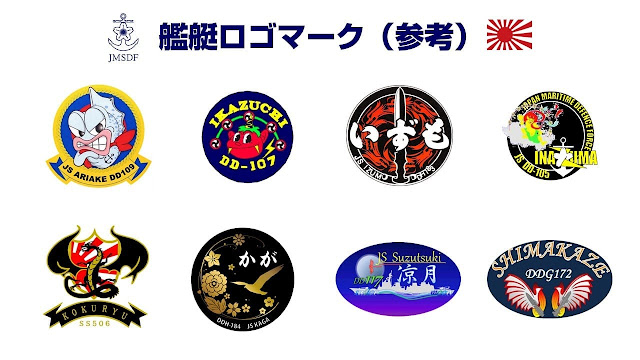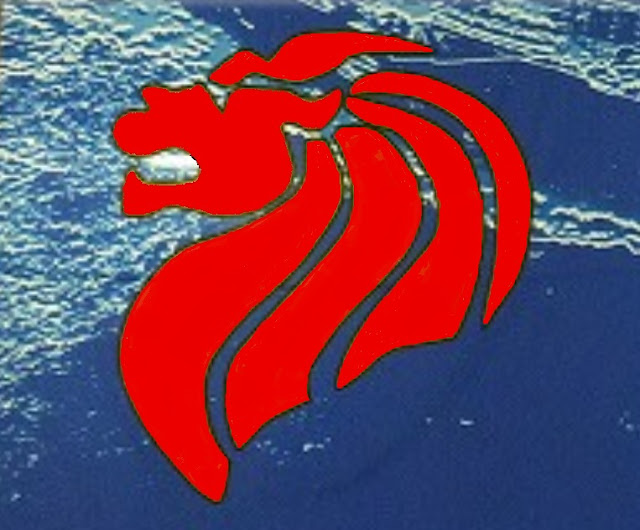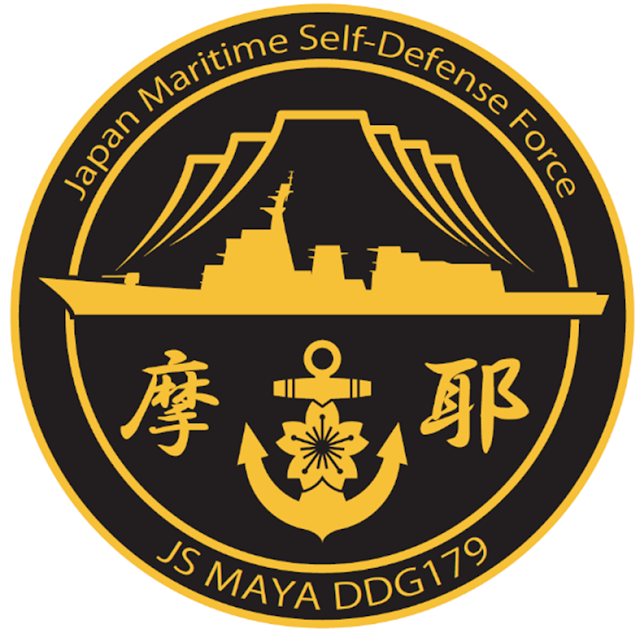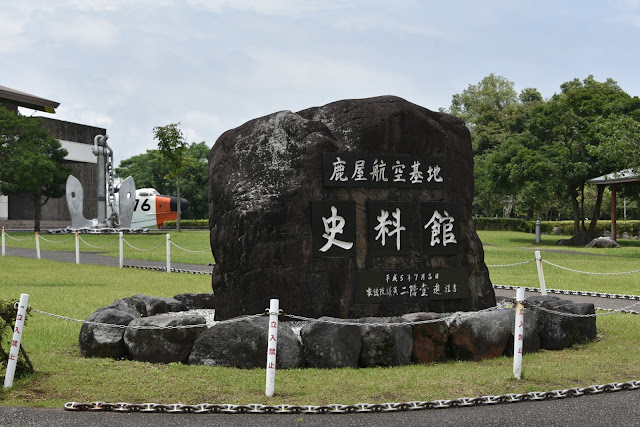 |
| Kanoya Air Base Museum |
I was in Kyushu in July for a trail run in the mountains of the Kirishima-Kinowan National Park amidst the torrential rain brought by Typhoon Danas. The weather was so severe that the course had to be shortened and the race terminated prematurely for many participants. Needless to say, I DNF.
Fortunately, the skies cleared the next morning and I took the opportunity to visit Japan Maritime Self Defense Force's ( JMSDF )
Kanoya Air Base Museum which is only about 60km from Kirishima City. JMSDF has in total three museums catering to different aspects of naval warfare in Kyushu and Honshu. The Sasebo museum deals with surface warfare, the Kure museum deals with undersea warfare and the Kanoya museum with naval aviation.
Kanoya Air Base And Museum
Kanoya is a city in
Kagoshima Prefecture located in the remote south-eastern part of Kyushu Island. Due to its southerly latitude and its proximity to the southern seas, Kanoya Air Base was extensively used for Kamikaze operations in the closing days of World War II. Today, it is the headquarter of Fleet Air Wing 1 with its P-3C Orion maritime patrol aircraft ( and the P-1 since July 2019 ), UH-60J search and rescue helicopter, as well as TH-135 and SH-60 training squadrons.
The museum is located just outside of the airbase and is accessible to the public seven days a week except during the New Year holidays. Admission is free of charge.
History and Purpose
The museum is popularly known as the Kanoya Sky Museum ( 鹿屋スカイミュージアム ) in Japan. It first opened in December 1973 and received a total of 840640 visitors up till December 1991 when it was closed for renovations. The renewed museum was reopened in July 1993 and has received 1904613 visitors until December 2018, a monthly average of about 5000.
The design of the 2-storey main building is rather drape and unexciting. It houses some 5500 artifacts relating to the history of Kanoya Air Base under the administration of the Imperial Japanese Navy during World War II and also post war and modern JMSDF naval aviation activities. Not surprisingly, it has a special section dedicated to the Kamikaze pilots, many of whom took off from Kanoya never ever to return. A immaculately restored Mitsubishi A6M5 Model 52c Zero fighter is displayed in this indoor area.
The extensive outdoor display area has many legacy maritime patrol aircrafts like the P-2V Neptune, S2F-1 Tracker and rotary crafts like the KV-107II but the most unique has to be the Kawanishi H8K2 flying boat from WWII. It is the one and only surviving specimen in the entire world but more of that later.
As usual, the purpose of these Self Defense Force museums are always for publicity and recruitment. There is no conscription in post war Japan and the SDF is made up entirely of career soldiers and these are always in short supply, made worse by the declining birth rates and shrinking population. The museum show cases the activities and equipment of the SDF with the hope of enticing young men and women to join its ranks when they come of age.
The Indoor Exhibits
A large hall with high ceiling welcomes the visitor to the museum. At the receptionist counter, the visitor book has only two columns for your signature. One column for visitors from Kagoshima Prefecture and the other column for visitors from all the other 46 Prefectures of Japan. There is no provision for foreigners or non-Japanese visitors as the museum is not expecting ANY. It is remote enough that many of the Japanese themselves may not have known about it far less make a visit. As such, be warned that the displayed exhibits are mainly in Japanese language only.
A floor to ceiling stained glass art piece depicting the active volcano
Sakurajima basking in the glow of the setting sun stands erect at the end of the entrance hall. Entitled Evening Glow on Sakurajima ( 夕映桜島 ) and crafted by artist Hirayama You, it was meant to recreate the last vision of Japan seen by the Kamikaze pilots as they depart Kanoya Air Base for their final suicide mission. The purpose of this art piece was purportedly to appease the spirits of these young men who sacrificed their lives for their country and to pray for world peace. It was installed at the museum in 1993.
 |
Stained Glass panel Yuei Sakurajima ( 夕映桜島 )
by Hirayama You ( 平山郁夫 ) |
Standing next to a pillar in front of the stained glass panel is a half sized bronze statue of a Kamikaze pilot entitled Special Attack Pilot's Statue ( 特攻隊員の像 Tokkoutaiin no Zou ) with a small display about the sculptor Fukushima Kiyohiko ( 福島精彦 ) who had to battle some chronic physical disability while sculpturing. These art pieces help set the tone for the extensive collection of Kamikaze related documents including dairies, last wills, photographs and personal belongings of the pilot that the visitor is about to encounter on level 2 of the museum
 |
| Special Attack Pilot's Statue by Fukushima Kiyohiko |
Photography was strictly prohibited within the special exhibit area on the Kamikaze Special Attack Corps out of respect for the deceased members. It was a good place to learn about the history of the special attack units as long as you can understand Japanese and have plenty of time to spend at the museum. As I only had a couple of hours to spare, I moved on to the adjacent room where the main attraction of the museum was displayed - a restored Mitsubishi A6M5 Model 52c Zero fighter. This was the only location on the second floor where photography was permitted.
 |
| Mitsubishi A6M5 Model 52c Zerosen |
The A6M5 Model 52c was an evolved late generation zero fighter that was first flown in Sep 1944. They were mainly used to intercept American B-29 bombers and for Kamikaze special attacks. The restoration effort has an interesting history as it combined the parts from 2 wreckages from different areas in Kagoshima. One was an A6M2b Model 21 salvaged from the beach near Tarumizu City ( 垂水市 ) which is located south of Sakurajima. The other was an A6M5 Model 52c fished from the seabed off Fukiagehama ( 吹上浜 ) in western Kagoshima.
 |
| Salvaging the Zerosen wreckages. |
The reconstruction works must have been monumental but the museum did a fantastic job. The Zero fighter looked immaculate and the cockpit can be viewed at close range with all the instruments in place. It looks primitive compared with that of a more modern fighter like the F-5. Even the Nakajima Sakae Model 21 radial engine is displayed next to the aircraft.
 |
| View of the cockpit |
 |
| The Nakajima Sakae Model 21 engine - 14 cylinder two-row air-cooled radial |
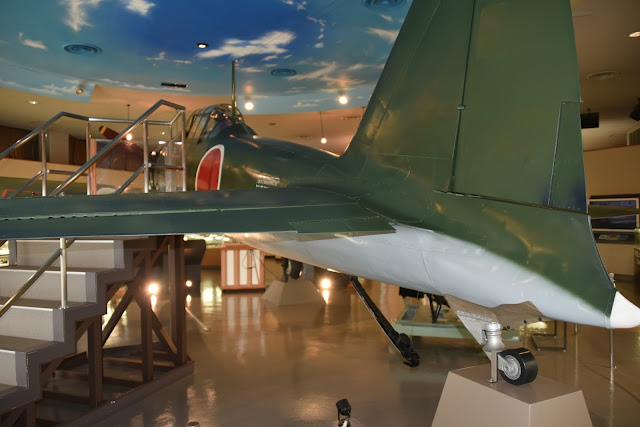 |
| The tail hook for catching the arrestor cable on the aircraft carrier flight deck |
 |
| All around the Zerosen are scale models of ship and aircraft and photographs of admirals. |
More displays await the visitor on the ground floor of the museum. You will come across many scale models of legacy anti-submarine patrol aircrafts like the P2V-7, P-2J, P-3C and amphibious aircrafts like the US-1 as you descend the stairs.
 |
| P2V-7, YS-11 and helicopter scale models |
On the ground level, an entire section is dedicated to search and rescue operations ( SAR ) with the displays centering on the partial airframe of a decommissioned Mitsubishi S-61A Sea King SAR helicopter. The visitor can enter the cabin and cockpit of the helicopter, walk around and see the winch, life raft and rescue basket up close.
 |
| Mitsubishi S-61A Sea King SAR helicopter |
 |
| Interior of the S-61A is surprisingly spacious |
 |
| Life raft, rescue basket and flotation device |
 |
| Close up of rescue basket |
 |
| S-61A cockpit |
The S-61A Sea King has long since retired and has now been replaced by the UH-60J Sea Hawk helicopter in the SAR role.
Still on the ground level but at a different corner is the front section of a Kawasaki P-2J Neptune anti-submarine patrol aircraft on display. This aircraft was most likely P-2J serial number 4770. A total of 83 were produced by Kawasaki between 1969 and 1979 with the last aircraft being s/n 4783. All had been retired from service by 1995, replaced by the P-3C Orion. The visitor can step up to view the cockpit or crawl through to the nose cone.
 |
| Front section of a P-2J Neptune ASW aircraft, likely s/n 4770 |
 |
| P-2J nose cone |
 |
| P-2J cockpit |
This is also where one can learn everything about the Neptune variants. The various consoles within the P-2J were faithfully reconstructed as museum display complete with the instrument panels and even the seats. They include the work space for the 2 acoustic sensor operators, the Tactical Co-ordinator ( TACCO ), navigation officer, non-acoustic sensor operator ( radar, Magnetic Anomaly Detector, electronic warfare ) , communications officer and ordnance officer.
 |
L-R : AW1 ( Acoustic 1), AW2 ( Acoustic 2 ), TACCO, Navigation,
AW3 ( non-acoustic sensors - Radar, MAD, EW ) |
 |
| Radio operator console |
 |
| Wright R3350-32W Radial Engine |
The Wright R3350-32W duplex cyclone 18 cylinder air-cooled radial engine that powered the P2V-7 is shown with parts of the propeller. A series of Japanese sonobuoys are also displayed from the primitive HQS-2 passive type sonobuoy with vacuum-tube technology to slightly more advanced all-transistor versions like the HQS-4 and its successor HQS-6 and even later versions HQS-12, HQS-31 and HQS-33. The JMSDF used US made sonobuoys from 1954, its year of inauguration, until 1958. From 1959 only domestically developed sonobuoys were deployed.
 |
| Cutaway display of various Japanese developed passive type sonobuoys |
 |
| HQS-5D sonobuoy with parachute |
A Mk 34 acoustic torpedo and a Mk 44 air-launched lightweight torpedo are on display with a ATM-84D air-launched Harpoon missile which can be carried by the P-3C Orion. A replica of a contact type sea mine is also exhibited in front of the nose of the P-2J.
 |
| Mk 34 Acoustic Torpedo ( front ) and Mk 44 Air Launched Lightweight Torpedo ( back ) |
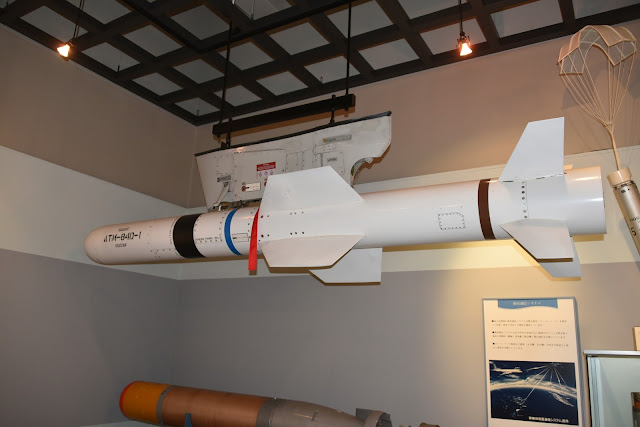 |
| A replica of the Harpoon missile on the pylon of an ASW patrol aircraft |
 |
| Contact type sea mine |
 |
| JMSDF uniforms |
So that more or less wraps up the museum's indoor displays. There are of course a few miscellaneous exhibits like uniforms, rank insignias, museum mascots and odds and ends but the outdoor aircraft displays awaits.
 |
| The Kanoya Sky Museum with its extensive outdoor exhibition of legacy naval aircrafts |
Outdoor Aircraft Collection
The over the years the Kanoya Air Base Museum has amassed a huge collection of legacy naval fixed wing and rotary assets. They include amphibious planes like the Shinmeiwa US-1, maritime patrol aircrafts like the Lockheed P2V-7 and S2F Tracker, trainers like the Beechcraft B-65 Queen Air and the Beech SNB-4 Expeditor, Kawasaki KV-107II mine sweeping helicopter, the ancient looking Bell 47 trainer helicopter, Kawasaki OH-6D and many more. Some like the Kawanishi H8K2 flying boat shown below is unique to this museum and can be found nowhere else.
Kawanishi H8K2 Model 12
 |
The last Kawanishi H8K2 Model 12 on display at Kanoya
Allied reporting name " Emily " Source Wikipedia. |
This large aircraft is known as the Nishiki Hikotei ( 二式飛行艇 ) or Type 2 flying boat in Japanese. It was considered one of the most outstanding maritime combat aircraft of WWII with its large capacity, long endurance and strong defensive armaments. The allied reporting name for the H8K was " Emily ". Of all the 167 built, this aircraft is the sole surviving specimen.
Unsurprisingly, the museum has made the H8K Nishiki Hikotei the official museum mascot and has created a caricature in the form of a flying whale called Nishiki Don. It has a counterpart that looks like a doggie with flappy ears that resemble wings called Hikotaro which means flying Taro. Taro ( 太郎 ) is a very common Japanese name for the male gender. The Hikotaro character was created to mark the museum's 25th anniversary.
You can read about the H8K2 Emily in my separate blog post
here.
 |
| The museum mascot Nishiki Don |
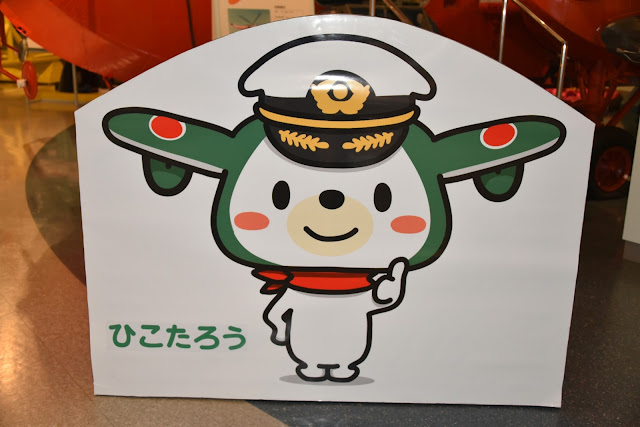 |
| The sidekick Hikotaro created for the museum's 25th anniversary |
Shin Meiwa US-1A
Next, the Shin Meiwa US-1A STOL Amphibian for Search and Rescue is probably also unique to this museum. The US-1A flying boat had been in service with the JMSDF only and had never been sold to any foreign nation. Affectionately known as Otori ( おおとり ) or Big Bird, the US-1A was credited with saving more than 500 lives from 1976 until 2017 when the type was retired from service.
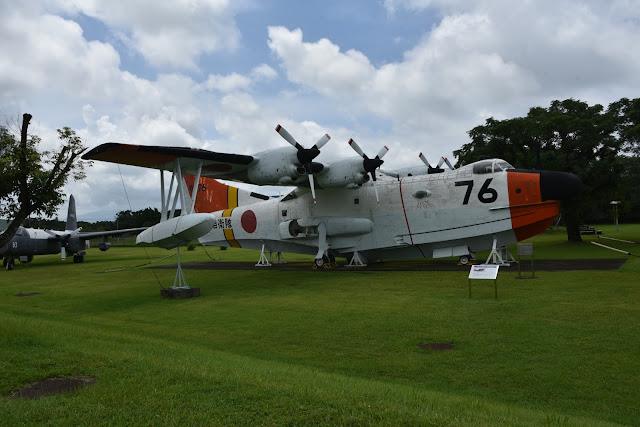 |
| The Shin Meiwa US-1A Amphibious SAR flying boat. |
 |
| The US-1A with a Kawasaki P-2J in the background |
 |
| The unique shape of the wave suppressor is clearly seen here |
 |
| The swiveling landing gear made the US-1A a true amphibian |
Grumman S2F-1 Tracker
Between 1957 and 1959, the fledging JMSDF received a total of 60 Grumman S2F-1 anti-submarine patrol aircraft under the Military Aid Program from the US. The S2F was the world's first purpose built single airframe ASW aircraft. It was later re-designated the S-2 Tracker. The Japanese nick-named theirs the Aotaka ( あおたか ) which most likely means blue eagle. The S-2 was powered by two Wright R-1820-82WA radials and could be armed with torpedoes, depth charges and rockets. The last of JMSDF's S-2F1 was retired on 30th Mar 1983.
 |
| Grumman S-2F1 ( S-2A ) with dorsally mounted ESM pod |
 |
| Side view of S-2F1 ( 4131 ) |
 |
| Rear view of S-2F1 |
Kawasaki P2V-7 Neptune
The JMSDF operated a total of 64 P2V-7 Neptune land based anti-submarine patrol bomber beginning from 1956. The first 16 aircrafts were transferred from the USN while the rest were either assembled or manufactured by Kawasaki. Together with the carrier capable S-2F1 Tracker, it formed the mainstay of JMSDF's aerial ASW asset. The Japanese nick name is Owashi ( おおわし ) meaning Big Eagle.
The P2V is powered by two Wright R-3350 32W radials augmented by two Westinghouse J34-WE-34 turbojets. The JMSDF retired its last P2V-7 in 1981.
 |
The P2V-7 can be distinguished from the P-2J by its
4 bladed propeller and single wheel on the main landing gear |
Kawasaki P-2J Neptune
The museum also has not one but 2 Kawasaki P-2J Neptune ASW patrol planes on display, though not unique to Kanoya, as far as I am aware, only the Kakamigahara Aerospace Museum in Gifu Prefecture has another P-2J on display. The P-2J was the license-produced and upgraded version of the Lockheed P2V-7. The radial engines of the P2V-7 were replaced by turboprops and the P-2J used 3 bladed propellers instead of the 4 bladed ones found on the P2V-7. The P-2J's main landing gear has 2 smaller wheels unlike the P2V-7 which has one single large wheel.
A total of 83 P-2Js had been produced with 82 new builds and one converted from a P2V-7. All P-2Js had been retired from service by May 1994.
 |
| P-2J serial number 4771 |
 |
| P-2J serial number 4771 |
 |
| P-2J serial number 4783 |
 |
The turboprop engine with a 3 bladed propeller
and the smaller turbojet mounted next to it.
Note the two wheels on the main landing gear. |
Fuji KM-2
The Fuji KM-2 was the licence-built version of the Beechcraft T-34 Mentor trainer. The JMSDF had 62 KM-2 as its primary trainer. It was nicknamed komadori ( こまどり ) which means robin in Japanese. All had been ben retired by 1998 but many improved versions spawned from the original KM-2. The KM-2B ultimately became mass produced as the T-3. The KM-2D had a turboprop engine and was mass produced as the T-5. The KM-2F aka T-3 kai ( improved T-3 ) was mass produced as the T-7.
 |
| Fuji KM-2 Trainer |
 |
| The KM-2 : Mother Of All Trainers |
Beechcraft SNB-4
The SNB-4 was the military derivative of the venerable Beechcraft Model 18. The JMSDF was provided with 35 SNB-4/5 in 1957 and deployed them for instrument flight training and navigation training until their retirement in 1966. They were nicknamed benibato ( べにばと ) which means red turtle dove. They were eventually replaced with the Beechcraft B-65.
 |
| The Beechcraft SNB-4 |
 |
| The Beechcraft SNB-4 |
Beechcraft B-65
Between 1963 to 1967 the JMSDF took in 28 Beechcraft B-65 Queen Air as trainers. The JMSDF has been using them as trainers for multi-engine aircrafts like the P-2J. They were nicknamed umibato ( うみばと ) which means pigeon guillemot. The B-65 were gradually being replaced by the TC-90 from 1974 and all have been retired by 1990.
 |
| The Beechcraft B-65 Trainer |
 |
| This Queen Air's vertical stabilizer seem to be missing its rudders |
 |
| B-65 Queen Air |
Douglas R4D-6Q
The R4D is the USN / USMC variant of the C-47 Skytrain / Dakota. The R4D-6Q is basically the C-47B ( later redesignated C-47J in 1962 ). The JMSDF had received a total of 3 aircrafts in 1958 one of which strictly speaking was an R4D-7. It was nicknamed manatsuru ( まなつる ) meaning white-nape crane. They were then the only transport planes of the JMSDF. They were replaced by the YS-11 in 1971. Two of the aircrafts were purchased by the US and sold to the Philippines leaving the last one on display at Kanoya.
 |
| Douglas R4D-6Q ( C-47B ) |
Kawasaki Vertol KV-107II
The Kawasaki Vertol KV-107II was the license-built version of the Boeing Vertol CH-46 Sea Knight medium lift helicopter. The JMSDF acquired a total of 9 such helicopters in 2 batches for mine sweeping duties and nicknamed them shirasagi ( しらさぎ ) which means white heron. The initial 2 helicopters were the KV-107II-3 model while the later 7 helicopters were the improved KV-107IIA-3 model. The displayed helicopter with serial number 8608 belongs to the later model.
 |
| The Kawasaki Vertol KV-107IIA-3 mine sweeping helicopter |
 |
| Rear view of the KV-107IIA-3 |
Mitsubishi HSS-2A
The Mitsubishi HSS-2A is the license-built version of the Sikorsky S-61B ( SH-3D ) Sea King anti-submarine warfare helicopter. 28 were built beginning in 1963. In addition JMSDF had another 55 HSS-2 ( SH-3A ) and 23 HSS-2B ( SH-3H ). The HSS-2B had been taken out of service in 2003.
 |
| Mitsubishi HSS-2A ASW helicopter |
 |
| The HSS-2A next to the bus bay of the car park |
Bell 47G-2
The Bell 47G-2 ( H-13H ) was license-produced by Kawasaki between 1954 to 1964. It had wooden rotors and 75 were built. It was nicknamed hibari ( ひばり ) meaning sky lark. It was mainly used for training, liaison and observation. It had been retired from service in 1982.
 |
| Bell 47G-2 |
 |
| Kawasaki / Bell 47G-2 |
Kawasaki OH-6D
The JMSDF acquired 14 Kawasaki OH-6D for pilot training manufactured under license from Hughes Helicopters ( now Boeing ). All have been retired by 2011 and had been replaced by the MD-500, the civilian version of the OH-6 which is still in production.
 |
| Kawasaki OH-6D next to parking lot |
 |
Main anchor of the IJN battleship Hiei ( 比叡 )
on display on museum grounds |
Is Kanoya Worth Visiting?
With so many interesting exhibits, Kanoya Air Base Museum is definitely a must visit site for military enthusiasts. A chance to see the world's last Kawanishi H8K2 Emily flying boat close-up already makes the trip worth while. Having said that, the museum is not without its short comings.
Its remoteness makes accessibility a real issue especially when the rail service does not extend to Kanoya. There are regular buses plying the Kagoshima - Kanoya route but it takes 2 hours one way and will cost about $18. Driving there in a rental car is probably a marginally better option but it still takes 1 hour 40 minutes through toll road. Fortunately there are ample parking spaces available and parking is free.
I noticed that most of the JMSDF aircrafts on display were those that had long retired and the museum lacks more modern aircrafts. The TC-90 trainer and the P-3C maritime patrol aircraft can be candidates to consider as both are being gradually retired. Scale models of the latest aircrafts like the Kawasaki P-1 can also be added to give the museum a more contemporary feel.
Another glaring deficiency is the state of the outdoor aircraft exhibit. Apart from the H8K2 flying boat, most of the aircrafts on display on the sprawling grounds around the museum looked somewhat neglected with weather-worn paintwork and even missing parts. If only these old warbirds could be repainted periodically and have some basic maintenance to spruce them up.
Without a roof to provide protection from the elements, the condition of the displayed aircrafts can only gradually deteriorate with time. I hope the JMSDF will consider building a large hangar as a permanent housing for the aircrafts, perhaps during the museum's next renovation. With typhoons getting more frequent and ferocious due to global warming, I do not think displaying the aircrafts out in the open is a wise option moving forward. The proximity of Kanoya Air Base to Sakurajima, one of the most active volcanoes in the world, also means that should a major eruption occur, all those precious aircrafts could be damaged.
Lastly, if you have gone that far south in Kyushu, also consider visiting the
Chiran Peace Museum in Kagoshima which is dedicated to commemorating the pilots of the Kamikaze Special Attack squadrons. It's an hour's drive south of Kagoshima City, or about 3 hours from Kanoya on the other side of Kagoshima Bay.



